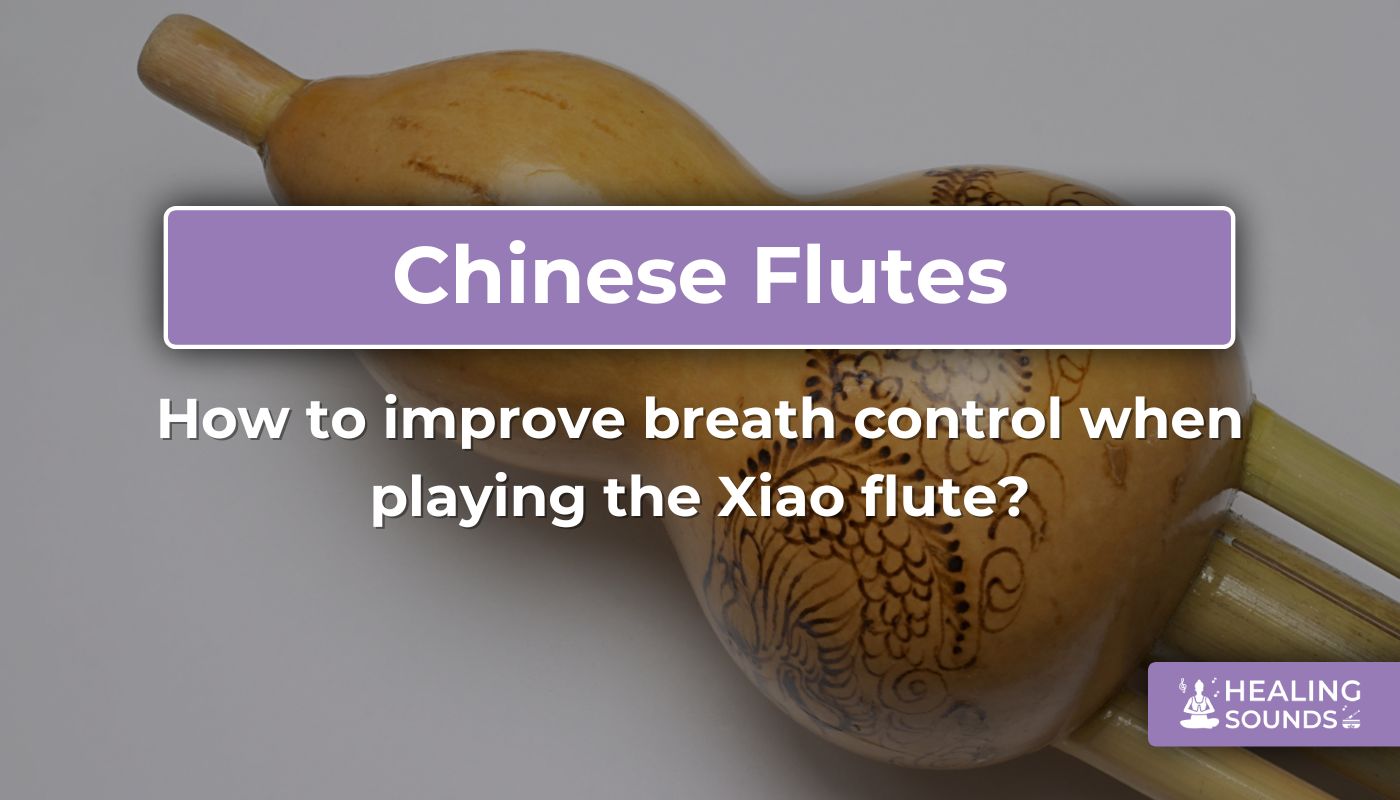Mastering Xiao flute breath control is fundamental for anyone wishing to evoke the deeply soulful and meditative tones of this traditional Chinese instrument. The Xiao, an ancient vertical end-blown flute often crafted from bamboo, offers a unique path to musical expression and relaxation, demanding precise airflow regulation. Whether you're just beginning your journey with the Xiao or are a seasoned player seeking deeper nuance, refining your breathing exercises for flute playing can profoundly enhance your sound and connection to the music. Let's delve into essential Chinese flute techniques to elevate your Xiao performance.
Why is Breath Control Crucial for the Xiao Flute?
The ethereal, gentle sound of the Xiao distinguishes it from louder flutes like the Dizi. Its character relies heavily on subtle variations in airflow. Effective breath control techniques are not just beneficial; they are essential for unlocking the instrument's potential. Proper breathing allows you to:
- Shape the Tone: Achieve the Xiao's signature warm, mellow, and introspective sound consistently.
- Sustain Notes: Hold notes smoothly and evenly for longer durations, crucial for the flowing melodies typical of Xiao music.
- Control Dynamics: Effortlessly transition between soft whispers (pianissimo) and fuller, resonant tones (forte).
- Articulate Clearly: Ensure each note begins cleanly and transitions smoothly to the next.
- Express Emotion: Use breath nuances to convey feelings ranging from tranquility to subtle melancholy.
Without mastering breath control, your playing might sound weak, inconsistent, or lack the expressive depth the Xiao is capable of producing.
Foundational Breath Control Techniques for Xiao Players
Building a strong foundation starts with understanding how to breathe correctly for wind instruments. These core techniques focus on efficient air intake and controlled exhalation.
Diaphragmatic Breathing: The Core Technique
The cornerstone of all wind instrument playing, including the Xiao, is diaphragmatic breathing (or 'belly breathing'). This technique utilizes the full capacity of your lungs by engaging the diaphragm muscle.
Instead of shallow chest breathing, focus on inhaling deeply so that your abdomen expands outwards. This method provides a larger, more stable reservoir of air.
- Sit or stand upright with a relaxed posture.
- Place one hand on your chest and the other gently on your abdomen.
- Inhale slowly and deeply through your nose, feeling your abdomen rise (your chest should move minimally).
- Exhale slowly and steadily through your mouth (or through the flute embouchure), feeling your abdomen gently contract. Aim for a smooth, controlled airflow.
Practice this daily, even without the flute, to make it second nature. For more detailed information on this technique, explore resources on diaphragmatic breathing benefits from health institutions.

8-Hole Silver Chinese Xiao Flute A/B/C/G Key
$69.99 $99.99
This metal Xiao offers a clear tone, excellent for practicing precise breath control and achieving stable, sustained notes.
Explore Silver XiaoRefining Your Airflow: Advanced Xiao Breathing Methods
Once comfortable with diaphragmatic breathing, you can incorporate techniques to further enhance control and expression.
The Role of Posture and Relaxation
Your physical state directly impacts your breathing. Maintain an upright, yet relaxed, posture whether sitting or standing. Avoid tension in your shoulders, neck, and jaw. Slouching constricts your diaphragm and lungs, hindering airflow.
Mindfulness and relaxation exercises can also improve your breath control. Tension creates uneven breath; relaxation allows for a smoother, more natural airflow essential for the Xiao's gentle voice.
Exploring Circular Breathing
Circular breathing is an advanced technique allowing players to sustain a note indefinitely by inhaling through the nose while simultaneously expelling air stored in the cheeks through the instrument. While challenging to master, it opens possibilities for continuous, unbroken melodic lines.
For most Xiao players focusing on meditative and traditional pieces, mastering basic breath control and long tones is more immediately beneficial than circular breathing. However, awareness of the technique is useful for those pushing advanced boundaries.
Discover Xiao Flutes for Your Practice

8-Hole G Key Handmade Bamboo Xiao Flute
$59.99
$89.99
Experience the classic, warm tones of traditional bamboo, ideal for developing nuanced Xiao flute breath control. Learn more ➔

8-Hole G Key Acrylic Xiao Flute for Beginners
$49.99
$69.99
A durable and easy-to-maintain option for beginners focusing on mastering breathing exercises for flute. Learn more ➔

8-Hole G Key Resin Xiao Flute - Portable and Durable
$179.99
$269.99
Offers excellent durability and consistent tone, supporting dedicated practice of Xiao playing tips anywhere. Learn more ➔
Practical Exercises to Improve Your Xiao Breath Control
Integrate these exercises into your daily practice routine:
- Long Tones: Choose a comfortable note (like the low tonic) and play it for as long as you can, keeping the pitch and volume steady. Focus on a smooth, controlled exhalation using diaphragmatic support. Time yourself and aim to gradually increase the duration.
- Dynamic Control: Play a single long note, starting as softly as possible (ppp), gradually increasing the volume to as loud as you comfortably can (fff), and then decreasing back to soft (crescendo and decrescendo). Maintain a stable pitch throughout.
- Breath Pauses: Play short phrases or scales, consciously taking full, relaxed diaphragmatic breaths during rests or between phrases. Avoid gasping or shallow breathing.
- Scale Practice with Breath Focus: Play scales slowly, focusing entirely on the quality and consistency of your airflow for each note. Listen critically to ensure an even tone across the scale.
Consistency is key. Even 10-15 minutes of dedicated breath work daily will yield significant improvements in your Xiao flute breath control.
Many effective breathing techniques for flute players mirror those used by singers. Exploring resources on how to improve your breathing for singing can offer valuable complementary exercises focusing on posture, support, and airflow control, directly benefiting your Xiao playing.
The Healing Connection: Breath, Sound, and the Xiao Flute
Playing the Xiao is often described as a meditative practice. The focus required for proper breath control naturally encourages slower, deeper breathing, which can help calm the nervous system, reduce stress, and promote a sense of inner peace.
The soft, soothing tones of the Xiao complement this process, creating an environment conducive to relaxation and mindfulness. As you master Xiao flute breath control, you not only improve musically but also enhance the instrument's potential as a tool for personal well-being.
Understanding the instrument's cultural context within traditional Chinese music can further enrich this experience.
Choosing the Right Xiao for Your Practice
The material and key of your Xiao can influence its responsiveness and feel. Traditional bamboo flutes offer warmth, while materials like metal, acrylic, or resin provide durability and consistency, which can be helpful when focusing purely on breath mechanics.
Beginners often start with a G or F key Xiao. Regardless of your choice, a quality instrument will make practicing breath control techniques more rewarding. Explore the different Xiao options available at Healing Sounds to find the one that resonates with your goals.
Conclusion: Breathing Life into Your Xiao Music
Mastering Xiao flute breath control is a journey that transforms your playing from simply producing notes to creating expressive, soulful music. By diligently practicing diaphragmatic breathing, maintaining good posture, consciously applying airflow techniques, and engaging in focused exercises, you unlock the true voice of the Xiao.
Embrace the process, be patient with yourself, and listen intently to the sounds you create. Improved breath control will not only enhance your technical skill but also deepen your connection to the meditative and healing qualities of this beautiful Chinese flute. Explore our collection at Healing Sounds to find the perfect Xiao to accompany you on this journey.
Frequently Asked Questions about Xiao Flute Breath Control
Hold the Xiao vertically with a relaxed grip. The angle affects airflow into the blowing hole; experiment to find the sweet spot (often around 45 degrees relative to your body). Ensure finger holes are covered completely but without excessive tension. Good posture is key for both comfort and breath support.
Focus on deep diaphragmatic breathing, maintain good posture, practice long tones to build capacity and control, and consciously manage your exhalation for a steady airstream. Regular practice of specific breathing exercises for flute (like scales with breath focus or dynamic control exercises) is essential.
Similar to flute playing, improving breathing for singing involves mastering diaphragmatic breathing, maintaining relaxed posture, and exercises that build lung capacity and control airflow (like hissing exercises or sustained vowels). These techniques directly benefit Xiao flute breath control as well.
The Xiao flute produces a soft, gentle, and mellow tone. It's often described as breathy, haunting, introspective, and calming, making it well-suited for meditative music and expressing subtle emotions. It's significantly quieter and less piercing than its cousin, the Dizi.
Mastering Xiao flute breath control is an ongoing process. You can see noticeable improvements in consistency and stamina within weeks or months of dedicated daily practice (15-30 minutes focusing on breath exercises). Achieving true mastery and subtle expressive control can take years of practice.

